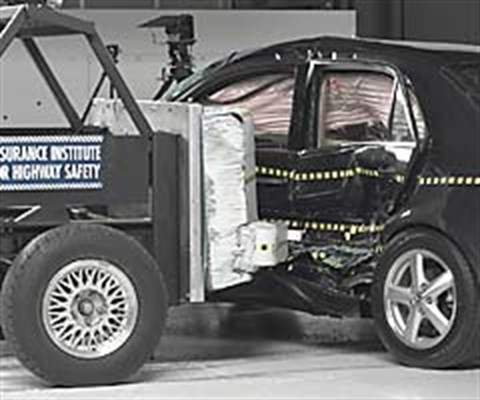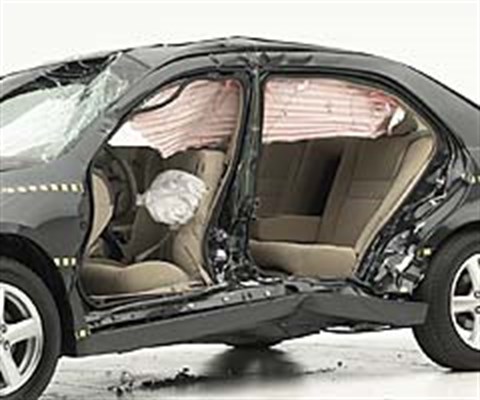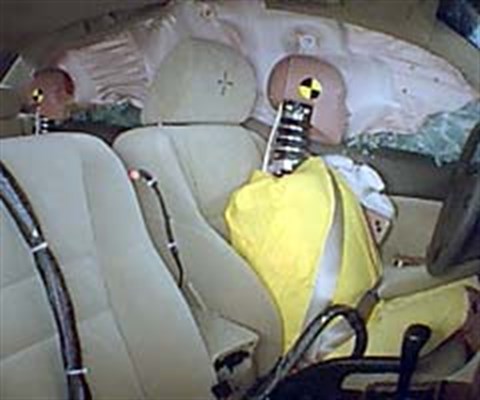Moderate overlap front: original test
Rating applies to 2003-07 models
Tested vehicle: 2003 Honda Accord EX 4-door
The Honda Accord was redesigned for the 2003 model year. The car received some rear-end styling changes in the 2006 model year.
| Evaluation criteria | Rating |
|---|---|
| Overall evaluation | |
| Structure and safety cage | |
| Driver injury measures | |
| Head/neck | |
| Chest | |
| Leg/foot, left | |
| Leg/foot, right | |
| Driver restraints and dummy kinematics | |

Action shot taken during the frontal offset crash test.

The dummy's position in relation to the steering wheel and instrument panel after the crash test indicates that the driver's survival space was maintained well.

Dummy movement was well controlled. During rebound, the dummy's head hit only the head restraint, as indicated by smeared greasepaint.

Intrusion into the driver's space was minimal, and all leg and foot injury measures were low.
Side: original test
Rating applies to 2005-07 models
Tested vehicle: 2004 Honda Accord EX 4-door with optional front and rear head curtain airbags and optional front seat-mounted torso airbags
The Honda Accord was redesigned for the 2003 model year. Beginning with 2004 models, design changes were made to the optional side airbags for the drivers' and front passengers' torsos. Beginning with 2005 models, side airbags were made standard.
Two tests of a 2004 Accord were conducted, one with optional side airbags for the driver and rear passenger, and one without. These vehicles are rated separately, except that the structural ratings for both vehicles are based on both tests.
| Evaluation criteria | Rating |
|---|---|
| Overall evaluation | |
| Structure and safety cage | |
| Driver injury measures | |
| Head/neck | |
| Torso | |
| Pelvis/leg | |
| Driver head protection | |
| Rear passenger injury measures | |
| Head/neck | |
| Torso | |
| Pelvis/leg | |
| Rear passenger head protection | |

View of the vehicle and barrier just after the crash test.

View of the vehicle after the crash with doors removed, showing the side airbags and damage to the occupant compartment.

Action shot taken during the side impact crash test showing the driver dummy's head was protected from being hit by hard structures by the side curtain airbag.

Smeared greasepaint shows where the rear passenger dummy's head was protected by the side airbag.
Head restraints & seats
Seat type: EX models standard seats
| Overall evaluation | |
|---|---|
| Dynamic rating | |
| Seat/head restraint geometry |
Seat type: LX models standard seats
| Overall evaluation | |
|---|---|
| Dynamic rating | |
| Seat/head restraint geometry |
About the head restraint & seat test
Currently, IIHS tests apply only to front seats.
